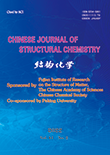A Terbium(III)-organic Coordination Polymer:
Synthesis, Characterization and Its Luminescence
MI Ying-Hao, YANG Ming-Xue, KUANG Xiao-Fei* and LU Can-Zhong*
Chin. J. Struct. Chem. 2022, 41, 2202079-2202084 DOI: 10.14102/j.cnki.0254-5861.2011-3277
February 15, 2022
coordination polymer, crystal structure, photoluminescence
ABSTRACT
A
new 3D terbium(III) metal-organic network [Tb(HIMDC)(HCOO)(H2O)]n (complex 1) has been synthesized by Tb3+ ions coordinated
with 4,5-imidazole dicarboxylic acid (H3IMDC)
and formic acid under solvothermal conditions with the mixed solvents of
N,N-dimethylformamide (DMF) and H2O. The unambiguous structural
determination has been confirmed by single-crystal X-ray diffraction combined
with elemental analysis, infrared (IR) spectrum, thermogravimetric analysis
(TGA) and powder X-ray diffraction (PXRD). Complex 1 crystallizes in orthorhombic Fdd2 space group with a = 22.295(2), b = 24.097(3), c = 6.7256(6) Å, V = 3613.3 Å3, Z = 16, Dc = 2.765
g/cm3, F(000) = 2816, μ = 7.855 mm-1, the
final R = 0.0173 (I ≥ 2σ(I)), wR = 0.0416
(all data) and GOOF = 1.068. In complex 1, the Tb3+ ions are connected by HIMDC2- anions into 2D metal-organic layers which
are further extended into a three-dimensional (3D) architecture through formic
acid functional motif. In addition, complex 1 shows intense and
characteristic green luminescence.








